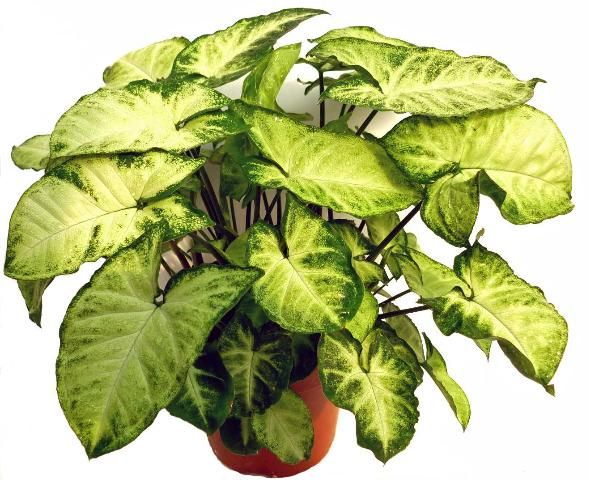Introduction
Syngonium is a perennial, evergreen, herbaceous vine of the family Araceae. Linnaeus originally classified Syngonium sp. as Arum auritum in 1763. Schott changed the name to its modern genera in 1829. Thirty three species are recognized and all are hemiepiphytic and native to moist, elevated forests of Mexico, Panama, El Salvador, Guatemala, Brazil, and Honduras.
Syngonium podophyllum (Figure 1), also known as arrowhead plant, nephthytis, African evergreen, and goosefoot plant, is the most commonly produced species in the foliage plant industry (Chen et al., 2005). It is recognized by its juvenile leaves, which are simple, alternately arranged, saggitate to hastate in shape, approximately 3–7 inches (7.5–17.5 cm) long and somewhat velvety. The common name, arrowhead plant, reflects the botanical leaf description. Mature leaves are dramatically different: they are compound with 3-11 elliptic leaflets, and the center leaflet may attain a length of 1 foot (19 cm) with a 2-foot (38 cm) petiole. The shape and color of the juvenile leaves is frequently used to name the cultivars that are commercially available. In most environments, each node sports adventitious roots. Flowers are a typical aroid spathe and spadix, white or cream colored with red or violet highlights, and are unremarkable.

This article is intended to describe common cultivars in the foliage plant industry, provide guidelines for their culture and interior use, and list physiological problems that may be encountered during production and interiorscape use.
Cultivars
Commercial cultivars are largely from S. podophyllum. Tissue culture propagation of this species has produced many new cultivars (Chen et al., 2006). Some of them are listed in Table 1.
Cultural Guides
Propagation
Syngonium propagation is easily done via nodal cutting, tip cuttings or air layers (Chen and Stamps 2006). The simplest method is to cut sections of the vine into single node or single eye (a single node with an attached leaf and adventitious roots) and place it directly into a rooting medium under mist. Air temperatures between 75°F and 95°F are recommended with bottom heating beneficial if the root zone is kept between 70°F and 75°F. Shade of 80% (2500 fc) is required for rooting. Some cultivars are propagated by seed. However, almost all commercial production has shifted to tissue culture liners.
Production
Liners, rooted cuttings, or seedlings are transplanted in 4-, 6-, or 8-inch pots and grown in shadehouses or shaded greenhouses. Commercial media formulated by combination of peat, pine bark, vermiculate, and/or perlite with pH of 5.5 to 6.5 and soluble salts of 1 to 2 dS/m are suitable for Syngonium production. Plants should be grown under 80% shade, in relative humidity of 60 to 100%, and in temperatures between 70°F and 90°F (Chen et al. 2005). If plants are fertigated via drip or ebb-and-flow irrigation, a nutrient solution with N at 150 ppm can be used. This solution can be made using a water-soluble fertilizer with N-P2O5-K2O at a 3-1-2 ratio, such as a 24-8-16 or 18-6-12 with micronutrients. If a controlled-release fertilizer with the N-P2O5-K2O ratio of 3-1-2 is used, apply it at rate of 6.5 lb N per 1,000 square feet on a quarterly basis or 26 lbs N/1000 sq. ft annually. Potting media should be kept moist but not wet when controlled-release fertilizers are used in production. Growers are strongly recommended to monitor the nutrient status of potting media by checking soluble salts levels biweekly using an electrical conductivity (EC) meter. Media solution can easily be extracted using the pour-through method. If EC readings fall below 1.0 dS/m, additional fertilization is needed; whereas if EC readings are above 3.0 dS/m, growers should reduce either the frequency or amount of applied fertilizer. It is recommended that fertilizer applications be reduced or eliminated one month before plants are shipped. Table 2 provides a general guide for determining if Syngonium is appropriately fertilized based on leaf analysis.
See Table 2.
Shipping and Interior Care
Shipping sleeves are recommended for transporting finished Syngonium. Recommended temperature range for shipping is 55°F to 60°F as exposure to a temperature below 55°F may cause chilling injury. Irrigate the media thoroughly the day before shipping to reduce stress during transportation.
Syngonium is commonly used as hanging baskets. If upright growth is desired, a totem, trellis, or other support is needed. Otherwise, plants can be used for ground cover. Optimal light levels for Syngonium in interiorscapes range from 250 to 1000 ft, and plants maintain their aesthetic appearance better if relative humidity is maintained between 40% and 60%. Allow the surface of potting media to dry slightly before irrigating. During the winter, reduce watering frequencies but do not allow the plant to dry out. Temperatures should remain between 65°F and 80°F to maintain leaf colorings. Occasional pruning is necessary to maintain plant form, and misting with water and wiping the leaves with a lint-free cloth will keep plants dust free and reduce the probability of a pest infestation.
Pest Problems
Although aphids, spidermites, scale, and mealybug infestations occur, they are relativity rare if the relative humidity is properly maintained. Snails, slugs, thrips, and whitefly infestations have also been reported but usually occur when plants are maintained in ground beds with minimal care. Most diseases that infect Syngonium occur during production. These include Erwinia, Pseudomonas, Xanthomonas, Myrothecium, Rhizoctonia blight, and Cephalosporium.
Physiological Problems
See Table 3.
Literature Cited
Chen, J., Henny, R.J., Devanand, P.S., and Chao, C.T. 2006. AFLP analysis of nephthytis (Syngonium podophyllum Schott) selected from somaclonal variants. Plant Cell Reports 24:743–749.
Chen, J., McConnell, D.B., Norman, D.J., and Henny, R.J. 2005. The foliage plant industry. Horticultural Reviews 31:45–110.
Chen, J., and Stamps, R.H. 2006. Cutting propagation of foliage plants. pp. 203–228. In Dole, J.M., and Gibson, J.L. (eds.) Cutting Propagation: A Guide to Propagating and Producing Floriculture Crops. Ball Publishing, Batavia, IL.